1734 Moving to the end
Dance Me to the End: Ten Months and Ten Days with ALS
by Alison Acheson
Victoria: TouchWood Editions, 2019 (also available as an audiobook)
$22.99 / 9781927366868
Reviewed by Lee Reid
*
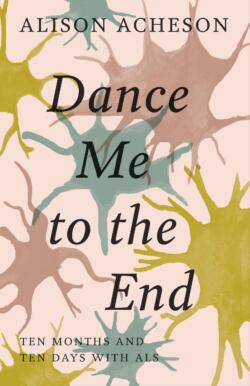 “What will become of me? Who will take care of me? Will you stay with me to the end?” People ask these questions when they are diagnosed with an irremediable condition such as terminal cancer, Parkinson’s disease, or ALS.
“What will become of me? Who will take care of me? Will you stay with me to the end?” People ask these questions when they are diagnosed with an irremediable condition such as terminal cancer, Parkinson’s disease, or ALS.
Dance Me to the End: Ten Months and Ten Days with ALS chronicles the life and death impact of ALS on a family, from 2015-2016. The book revolves around Marty, the lovable musician-teacher husband, and the progression of his ALS as narrated from the viewpoint of his wife, Alison Acheson. Five evolving characters, whom writer Alison initially calls “the team,” inhabit the true life saga. We meet Alison in her early fifties, author of ten+ books, mother, “recovering introvert,” and part-time teacher of creative writing at UBC. There is outgoing and funny Marty, in his late fifties; and their three young adult sons. As Alison discovers and advocates for more resources along their journey through ALS, other unusual characters or creatures enrich the team. We meet Martha and Mary (inner practical and intuitive aspects of Alison), a pet peripatetic snail, the wise and helpful “Doctor K,” an occasional spider, Alison’s parents, and “Batwoman,” who is the warrior woman side of Alison. Batwoman is a fiercely protective advocate for maintaining family connections, and for her husband (and herself) to receive compassionate treatment.
Although ALS is a tragic topic, a topic that requires courage to document, the sadness is leavened with comical and whimsical vignettes of daily family life throughout the book. “After their dad passed away,” Acheson relates, “if our sons were sitting watching something together, one of them would say, ‘Here’s Dad!’ and bring the television volume to a full 46. They’d share this memory, and a warm laugh, and then turn it back down. Legacy” (p. 220).

Alison’s narrative style is reflective and rich with ethical self-inquiry into her values and reactions. Judgements, made either by herself or by other people, do not escape her careful and compassionate questioning as she undergoes the heroine’s journey through a dark mythic underworld of pain, love, and death.
The book has a tender authentic honesty, a sense that Alison is saying and feeling what others might cover or gloss over with “nice.” Where else might you hear the surprising question that people pose to her as she researches a project about caregiving: “How do you not hate the person you are caregiving?” (p. 154).
Much of the book explores the exhausting or sacrificial role of caregiver, which devolves on Alison. Although she elicits help, and friends sponsor a fundraising drive for the couple, one wonders how other caregivers fare when alone without the support of family or community. Facing death alone is all too common a reality for aging spouses. Alison rises to the daunting role with resilience, carefully skirting the stereotypes of martyr or heroine, although these labels certainly might occur to readers. How? Alison is strong but vulnerable, and she writes from a vulnerable place that invites relationships to be reciprocal. What might disturb readers is not the book or ALS. It is the areas of “othering” or lonely separateness, where characters opt to hide their inner feelings and selves behind inscrutable walls.
ALS tends to affect men more than women. Women live longer and they carry more cultural expectations to provide compassionate tending or parenting, often ending up with the job of caregiving their spouses or friends or parents, as well as their children. Typically, ALS afflicts people over age 50. With the role of home caregiving comes the need for attention to detailed planning in every aspect of patient (Marty’s) care, but also the role of educating the family (their boys), oneself, and the public about the many aspects of ALS, and especially about sensitivity. Dance Me to the End has a high sensitivity IQ. For example, Alison wrestles with timing. When and how does one tell children that their dad will die, yet protect their hopeful optimism? How and when does one prepare a spouse with ALS to accept the insertion of a feeding tube along with assisted feeding, or to accept help with toileting, moving, eating, being driven, and sleeping? Since every small change can undermine Marty’s dignity or cause more pain, each change must be handled with sensitivity for the emotional and physical limitations caused by ALS. “The teacher in me wonders what it would be, every lesson, every class, if every learner — and the teacher — slowed to the slowest in the room: what would we notice? What would change? Or would we be filled with impatience?” (p. 142). “Slow” defines ALS and slow becomes a major education for the family and for readers.
Much of Alison’s internal reality is subtle, yet the effect on the reader is powerful. “I was learning that dying and death does not fundamentally change people (p. 35)” “…up and down became a pattern. A new normal” (p. 22). Living with a progressive disability is a delicate process for everyone. How did Alison manage to teach a university program while her spouse was dying? “I crossed that courtyard, grey and wet, and felt sudden breath-stopping deep red panic, followed by an urgent need just to be home. I continued to my class, struggling to quash that feeling, and taught the two hundred plus students” (p. 155).
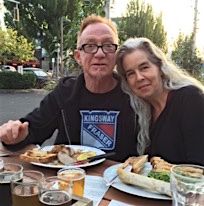
The medical term for ALS, also known as Lou Gehrig’s disease, is Amyotrophic Lateral Sclerosis. More commonly it is called “creeping paralysis” or MND (motor neuron disease). “Amy” and “trophic” mean starved or malnourished muscles; “sclerosis” means hardening or scarred. “Lateral” indicates the spinal areas where motor neurons are located … which move our muscles. ALS is a terminal neurodegenerative condition that causes atrophy of muscles, paralysis, inability to eat or breathe, as well as cognitive decline. Ideally, the prognosis is a painless death in one’s sleep. Death is usually due to respiratory failure. ALS sounds chilling when spoken slowly, with emphasis on each word: Amytrophic. Lateral. Sclerosis.
Dance Me to the End is the kind of book you would hope to discover when you feel stuck, or when you seek clarity and energy to make changes to your life. When you are uncertain about how to support a friend who is struggling, this book will speak to you. Change is non-negotiable with conditions like ALS or Parkinson’s or cancer. For more extroverted people like Marty, who tend to avoid inner reflection or who cannot articulate feelings and sensory changes in their body, Dance Me to the End demands that readers (and professionals) listen deeply to the lived experience of vulnerable people. Ask sensitive questions about their reality. Alison Acheson does this by pointing out the occasions when professional helpers completely miss who their patient really is, either by treating the spouse she loves like “the body in the bed” (an object or a stupid person), or as a person to be lectured. Then again, the dilemma faced by the author reflects one of the many paradoxes she must contend with: does she ask too many prodding questions, or not enough? She wonders if accepting and acknowledging the ravages of ALS is akin to despair. What is the difference between acceptance and resignation? She discovers that there are no clear measures of what works one time with her husband, and what can totally miss the mark the next time. Alison forges new values about “the work:”
To leave loved ones knowing they are loved, have been loved, with as clean as possible a pain, might be a significant piece to this human work. Having time with the knowledge that one is leaving this place is some compensation for having to live with that knowledge. Perhaps time can be a gift (p. 59).
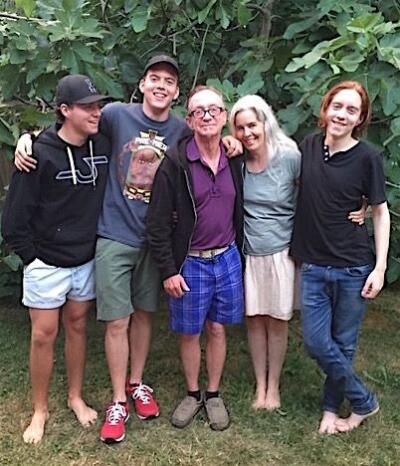
Alison models the resilience that caregivers are forced to develop when faced with frightening unknowns and challenges. “Martha” represents the efficient and practical part of her nature and “Mary” is the intuitive dreamer. “Martha” elects to do extensive research and reading about ALS. She asks questions and she studies testimonials from other ALS sufferers. Although it is nerve-wracking work, Martha figures things out by trial and error and is willing to risk mistakes. “Mary” attunes to every nuance and change in her husband, his environ, and in herself, hoping to forestall the progression of ALS before each stage becomes critical or painful. “Martha,” while cooking for her family, while keeping the family together with their social rituals of barbecues and movies, orders or installs special equipment for feeding, bathing, sleeping, and mobility. “Mary,” who longs to dance and take time for the reflective and spiritual, seeks nurture for her imagination in writing and nature and music.
Despite the work of caregiving and inevitability of dying, readers might find this book to be comforting, even reassuring. Why?
Alison has the gift of directly speaking to the hearts of people who feel vulnerable. When life mandates that you let go of control and task-managing, when life demands that you remain functional but feel myriad emotions simultaneously, you might find that this gem of a book will reduce the anxiety or the loneliness. In many cases, Alison employs poetry or cryptic chapter headings such as “To Seize” and “Pieces” that express the grief and the grace. The trajectory with ALS is progressively tragic, yet the emotional presence, breakthroughs of joy, and hard-won wisdom enfold the reader with gentle solace. “One can need to be, and feel, many things at one time, all the time. I was learning that that is what, in part, causes the exhaustion of caregiving” (p. 49). Many chapters evoke grief, loneliness, or despair, but then an undercurrent of beauty bubbles up. When it seems there is no relief from disasters or pain in this book, small moments of deep connection among the characters or with nature soften the fear and grief. “It was dusk and the sky had that luminous indigo teal to it … I spoke my thought about how everyone now said, ‘Life is cruel.’ But the planet is still beautiful” (pp. 41 and 44).

Dance Me to the End teaches readers how to remain sensitive during critical transitions in life; transitions that shatter daily identity, hopes, and relationships. “Who will take care of me?” holds a particular irony for caregivers when the compassionate promise we make to comfort one’s loved one to the “end” gets buried under the exhaustion and demands of providing 24-hour nursing care at home. Or when a family is in conflict about their dying member using “MAiD” (medical assistance in dying) to end their life. Does one still want to care-take when the ailing person becomes critical, demanding, or abusive? Or when the loved one has mentally disappeared due to dementia and is unresponsive and unappreciative? The cultural judgements toward women who opt to stop caregiving at home are particularly onerous, especially if they choose to place the patient in a nursing facility. They may encounter social disapproval or condemnation or even blame. Many women contend with shame, fearing they will be judged as cowardly and selfish, if they choose respite from caregiving. Would men experience the same shame if they placed their family member in nursing care?
Alison is forced to sort and keep secret the clothing and items that can no longer be used by Marty, commenting ruefully that this is her “Martha” self. Martha the manager and doer. As her skills grow, so does the “team.” Music, which her husband taught in his home studio, becomes her “drug of choice,” her muse. Music helps her to release the grief and anger.

Readers might reasonably wonder why anyone would want to go through prolonged home nursing if it magnifies the worst traits of one’s harsh inner judge. Do people make the choice to die at home without realising the consequences? When whatever help Alison offers is either rejected or fails, she struggles with her internal “I’m not good enough” failure messages. “But where was my spine, I wondered,… how did one stand up to a dying person? A dying person in pain. Or do you stand up?” (p. 219). She seeks solace in reading books, dance class, walking, contemplation, all of which remind her of the creative Mary-spirited woman she is, not just the responsible Martha.
Alison is stretched to eke out time for minimal self-care. In many ways, the grief shared in this book is the grief that we feel when trapped in a lifestyle or body that no longer works … where we lose our connection with self. This loss of self may resemble depression or trauma, but it holds a unique quality of not-quite-hopeless suffering when one can see no way out. The choice then becomes a heads-down endurance marathon; plodding through each day, or a desperate search for glimmers of hope. Alison learns to live moment-to-moment, focusing on essential doable tasks by banishing the complexities to her journal, and this is where the secrets spill out … to eventually become this book about Marty and ALS.
Throughout the story, sensible Martha seems to dominate as she strives to fix the unfixable. But the future beckons Alison’s inner Mary, albeit as a woman living alone. “Mary, Mary, Mary with your slim hips. Let me follow you (p. 72).” “I needed to think about this being old and alone. But we are alone. What did it mean to be alone? Do we pick up the phone and call someone to join us? Or do we sit with it, live with it?” (p. 98).
How Alison navigates her identity, aging, her family, her work, and Marty’s ALS shapes a compassionate chronicle of caregiver survival. But the book is not all about caregiving. It is as much about relational cycles of finding and losing human connections. How to retrieve oneself from the fight-flight-freeze cycles of trauma or PTSD? Any one of us could be in Alison’s precarious position when a family member is dying. Or if diagnosed with a disability. Or when feeling exiled, such as leaving the home, work, or country where much of your life took root. With precarity (which is a new term for the angst of aging), buried secrets are inexorably exposed, to be replaced by new vulnerabilities. “Less than two weeks in and it was hard to keep secrets, yet hard to share and feel people leaning on me. At this point, it wasn’t so much something I could articulate as it was an awareness of Things To Avoid …. not for the first or last time I wondered, is this my life? Had I blundered into someone else’s?” (p. 29).
Inasmuch as Alison’s narrative chronicles the life and death of her musician husband Marty, it is also ruthlessly honest about her own inward battles and anger as she sets aside her freedom, identity, and creative passions to care-take him.
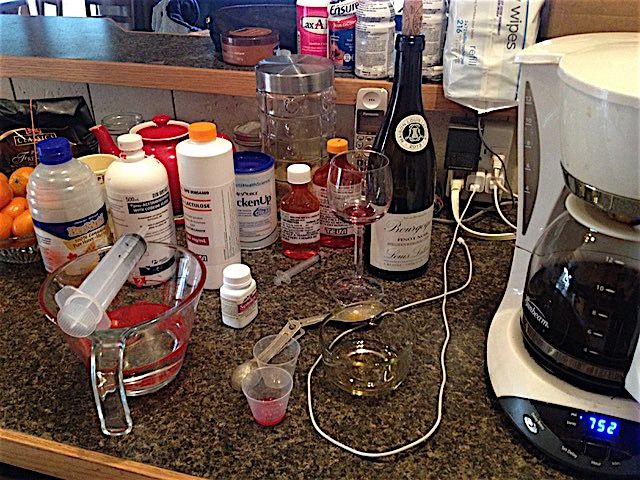
“As we set out into the new year of 2016, I questioned how it was the sadness that was overwhelming,” she records. “Anger or a sense of unfairness would be easier to live with. The sadness deep in my husband was harder to accept, though; his loss was so much greater than mine. But sadness would keep me human, while anger and bitterness would make me miserable” (p. 190). Before Marty dies, she often wonders how people manage living alone. Does comfort come from memories and mementoes … enough to heal a broken heart? “Is this what widows do?” she ponders. She watches older women living happily alone supported by a few friends and creative pursuits, and wonders: do they rely on family nearby, as she does with her sons and parents? Then again, within her own extended family, she sees the opposite spectrum of happy independence, which is loneliness and decay. “The smell in the room was the sour smell of an old woman …. A lonely room, an alone woman. Age just covered it, wrapped it, sorrowed it” (p. 29). And she wonders, “Next summer, who will I be?” (p. 110).
Despite her exhaustion, Alison clings to attending her dance class. It renews her. In the Leonard Cohen song Dance Me To the End of Love, we see older and younger couples of varying cultural backgrounds dance to haunting violin melodies (p. 71). With a grace accumulated from sharing lifetimes together, they weave intimate cocoons of love. By contrast Marty, with ALS advancing, cannot dance or move easily and, although he is clearly sad or scared, he avoids sharing his inner process. Marty elects to play golf until he can’t. Alison hides the wheelchair that he must eventually surrender to. Will she too lose her dance?
In the Cohen video and song, when one partner dies, the remaining lover dances a poignant solo before the empty chair or the photo of the beloved. “Dance me to Your Beauty With a Burning Violin… Dance me Through the Dance Till I’m gathered safely in,… Raise a Tent of Shelter now that Every Thread is Torn …Dance me to the end of love.” (Words and music by Leonard Cohen. Copyright 1985 Sony /ATV music publishing LLC and Stranger Music Inc.).
Alison wrote Dance Me to the End as a completion for her 25+ year marriage with Marty, as an epitaph to his death in 2016. “I remembered the wish to grow old together — . And we did. We just grew old before our time” (p. 289). Although she dances Marty to the end, she discovers that there is a toileting boundary that others will not cross with caregiving. Friends articulate that they would prefer to be placed in a nursing facility when no longer able to “wipe one’s own ass.” Alison reflects, “Truth is I’d gladly wipe an ass if I thought the receiver of the wiping could find a way to accept it, to look me in the eye afterward, would let me hold his hand — after a good wash, of course. I’m being facetious because humour is necessary to my well-being” (p. 293).
As the ALS dance begins, a friend suggests to Alison: “Never Turn Down Any Offer of Help” (p. 33). Did she anticipate the anguish and hard work? Alison questions the widespread romantic myth that a major disease will bring a couple or family closer together, “…which is, to my mind, a spectacularly stupid thing to say — to assume. But at the outset, it seemed desirable, possible” (p. 73).
What readers discover in this book is that the caregiver is often stretched far beyond what they think is tolerable. Nonetheless, caregivers do what must be done. Perhaps, muses Alison, it is more merciful not to know what lies ahead. Just focus on managing each moment with as much sensitivity as possible. Nothing can be taken for granted because Marty could choke on a piece of lettuce or scream in agony if slightly moved. A friend queries, “How much time do you spend wishing things weren’t what they are?” (p. 20). This measure helps Alison to steer clear of hopelessness, or of rage towards helpful people who make ignorant suggestions. Alison realises that grieving people, like herself, frequently wind up with earaches and infections: the accumulation of unshed tears (p. 119).

The last half of the book is dominated by “Last Time” awareness. Alison wonders how people invite conversations about dying if one spouse denies death or does not want to talk about it? “What will be the last time … for sleeping in one’s bed, for one’s work or creative skills, for relationships or walks?” When the routines of contact must end, every moment is punctuated with “last time.” “Would I ever experience pleasure again? If I could, would I do so without guilt? The guilt of being the one left behind, alive” (p. 103).
What I found toughest in Alison Acheson’s book was the violence of silence. “That urge to tell my children, that urge that had filleted my gut, I wrapped in duct tape and stuffed into the back of the closet. For the time at least” (p. 35). What replaces tenderness or reciprocal appreciation is the slow torture of seeing life disappear:
Months later, when so many muscles had shut down, he developed a way of closing his eyes with a slow sweep and looking away dismissively. The message was clear. I don’t want to talk about it. This element of caregiving — tough conversations — made me ponder the complexity of being care-recipient. Tougher to receive than to give, came to mind (p. 59).
Alison wonders how to remain positive or loving when feeling fractured, or when a loved one’s voice is reduced to a semblance of orders and commands mandated by pain? “Go gently when life is pushing you….Timing is everything” (pp. 207 and 209).
She questions, “How were we going to get through this if we didn’t open it up and look at it? Yet why would we? We’d never talked enough about things that were under the surface. I hadn’t realised until then how little time we spent in this way…. but had we created a culture of silence between us?” (p. 59). As he develops “flat face” from the slackening of muscles, she can no longer read her husband’s feelings.
Overall, Dance Me to the End is masterful with the language of nuance. Alison writes in a delicately compassionate style that cuts deep to the bone. Each chapter describes a new transition into living with ALS. Each presents a fragile psychic space for readers to consider. Since many of the transitions are not talked about in their marriage, we see the walls and separateness that develop in lieu of communication. Much as they love each other, Marty and Alison cannot always share their mutual grief, nor comfort each other through their vulnerability:
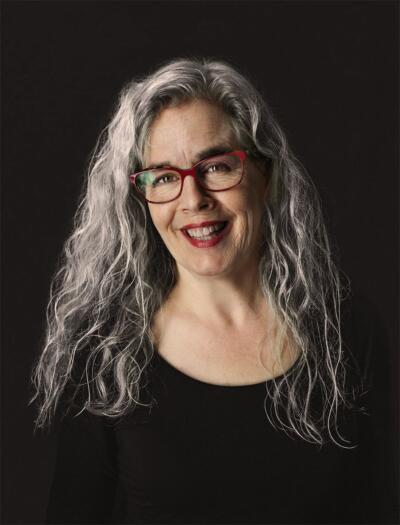
This beside her is something silent and violent. More than anything she wants sound and movement to know what it is she is living with. But there’s just this darkness. There is pain here. Her husband’s pain leaks into her. She can feel it like an acid into her skin, through her bones (p. 138).
As Marty’s ALS progresses, so too does silence. Alison envisions a dense blackness approaching to seize him. He reacts by turning up the volume, full force TV, radio, and music.
What might be insightful or controversial for readers is the message that the patient or “recipient of care” also has work to do. Work is not strictly the domain of the caregiver, and dying does not mean people cannot grow emotionally or spiritually, whether separately or together. “There are types of work that are significant to who we are, work that simply must be done. Becoming human is a wonder-filled burden we carry. Moving from one age to another. Moving to the end” (p. 59).”
As Leonard Cohen would say, “Thanks For The Dance.”
*
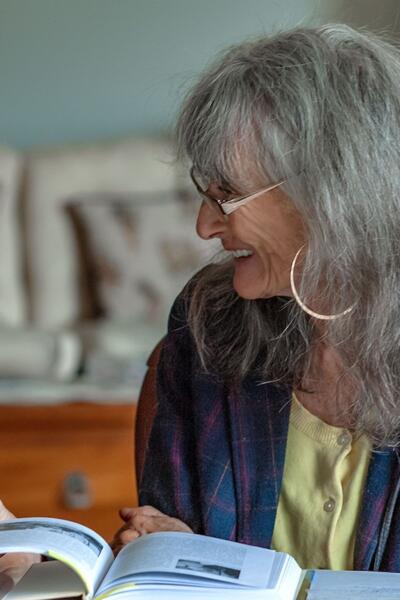
A retired clinician formerly with Nelson Mental Health, Lee Reid has written four books about BC rural and coastal communities. Her stories centre around the values and health care needs of BC seniors. Lee has also written stories about intergenerational education, rural home support care services, trauma, and dementia. Her books are: From a Coastal Kitchen (Hancock House, 1980); Growing Home: The Legacy of Kootenay Elders (Nelson, 2016), reviewed by Duff Sutherland, and Growing Together: Conversations with Seniors and Youth (Nelson, 2018), reviewed by Luanne Armstrong. In 2021, she self-published a fourth book, Stories of Mount Saint Francis Hospital: 1950-2005, which illustrates a legacy of compassionate nursing care at an historic extended care hospital in Nelson. Visit her website here. Editor’s note: Lee Reid has recently reviewed books by Stefanie Green, Leslie A. Davidson, Phyllis Dyson, Joan Neehall, Janie Brown, and June Hutton & Tony Wanless for The British Columbia Review. In 2018 she contributed a popular memoir of growing up in the south of England and North Saanich, The Spider Hunters.
*
The British Columbia Review
Publisher and Editor: Richard Mackie
Formerly The Ormsby Review, The British Columbia Review is an on-line book review and journal service for BC writers and readers. The Advisory Board consists of Jean Barman, Wade Davis, Robin Fisher, Barry Gough, Hugh Johnston, Kathy Mezei, Patricia Roy, Maria Tippett, and Graeme Wynn. Provincial Government Patron (since September 2018): Creative BC. Honorary Patron: Yosef Wosk. Scholarly Patron: SFU Graduate Liberal Studies.
“Only connect.” – E.M. Forster
6 comments on “1734 Moving to the end”
What a marvellous review of what I imagine to be a book we all should read.